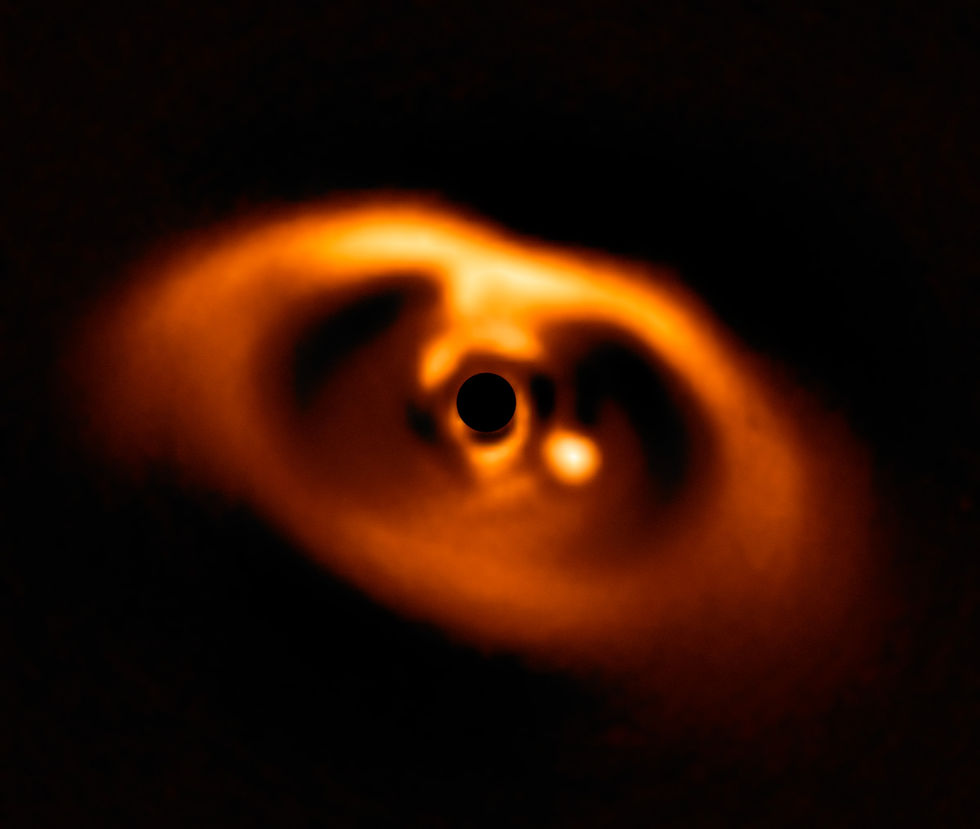The youngest planet discovered by the Hubble telescope is the size of Jupiter and continues to grow!
- Sri Sairam Gautam B
- May 6, 2021
- 3 min read
The Hubble Space Telescope took a look at the cosmos and spotted its newest exoplanet, a giant world 379 light-years away from Earth that is still growing.
Planets form as dust and gas, swirling around in a circumstellar disk surrounding their star, collides and condenses to slowly become a "ball." Far out in the constellation Centaurus, Hubble has spotted a planet still coming together. The young giant gas exoplanet, known as PDS 70b, is 'just' five million years old, Hubble scientists said. As the planet accumulates more mass, pulling it out of the young star it orbits, it is already huge - about the size of Jupiter.
In a new study, scientists took advantage of this once-in-a-lifetime opportunity to study a planet in its formative years as PDS 70b with the telescopic eye of Hubble.
'This system is so exciting because we can witness the formation of a planet,' co-author Yifan Zhou, also of the University of Texas in Austin, said in a statement. "This is the youngest world Hubble has ever photographed."
The researchers were able to utilize Hubble's ultraviolet-light sensitivity, which allows them to spot and measure radiation from the hot gas that falls into forming planets, the researchers directly measured the mass growth rate of PDS 70b.
"Hubble's observations have allowed us to estimate the velocity at which the planet is gaining in mass," Zhou said. This is the first time that researchers are in a position to measure the mass growth rate of the planet.
They were also able to observe the planet directly and discovered that it appears to be reaching the end of its training process.
In addition, the team saw several “hotspots” glow in ultraviolet light, which Hubble is ready to detect. These hot spots, the researchers think, are caused by hot material that extends down to the planet's surface from magnetic field lines that stretch from the planet's atmosphere to its star's circumstellar disk.
"If that material follows the columns of the disk on the planet, it would cause local hot spots," Zhou said. "Those hot spots could be at least 10 times warmer than the global temperature."

While Hubble has spotted over 4,000 exoplanets to date, about 15 have been directly pictured also, most of these 15 exoplanets looked like dots in the pictures, since they are so far away and small.
"We don't know much about the way giant planets develop," author of the study Brendan Bowler from the University of Texas at Austin, said in the same statement. This planetary system gives us the first chance to watch materials fall on a planet. Our findings are opening up a new field of research."
The researchers recognized that these observations of PDS 70b are not a complete picture of the exoplanet. Additional data is necessary to confirm the rate of mass growth and further explore the planet. A more detailed study of PDS 70b may help to understand how similar gas giant planets form.
While studying PDS 70b, researchers used a new technique that they think "paves a new route for further exoplanet research, especially during a planet's formative years," according to the statement. In this technique, Zhou removed glare originating from the star in the 70b PDS system.
Starlight glare can be a challenge for scientists studying distant objects like this exoplanet, and researchers often struggle to study exoplanets near their host stars. So, by removing the glare the team got a better look at the planet and they paved the way for future researchers to study planets that are closer to their host stars.

Credit: ESO/A. Müller et al.
"Thirty-one years into the launch, we're always finding new ways to use Hubble," Bowler added. "With future observations, we could potentially discover when most of the gas and dust hits their planets and if it does so at a steady pace."
Originally posted on "Space.com".




Comments